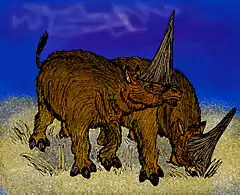Elasmotheriina
Les Elasmotheriinae ont été renommés Elasmotherina (en 1989)[1] - [2] et ont été reclassé en sous-tribu éteinte des Rhinocerotini dans la famille des Rhinocerotidae. Ce groupe a vécu du Miocène inférieur (Bugtirhinus des collines des Bugti au Pakistan) au Pléistocène supérieur (Elasmotherium)[1].
Elasmotheriina

Dessin très schématique de deux Elasmotherium.
| Règne | Animalia |
|---|---|
| Embranchement | Chordata |
| Sous-embr. | Vertebrata |
| Classe | Mammalia |
| Ordre | Perissodactyla |
| Famille | Rhinocerotidae |
| Sous-famille | Rhinocerotinae |
| Tribu | † Elasmotheriini |
| Sous-tribu | † Elasmotheriina |
Physiologie
Les Elasmotheriina sont des rhinocéros de grande taille, plutôt élancés et adaptés aux milieux ouverts. Ils possédaient de grandes cornes caractéristiques comme, entre autres, celle d'Elasmotherium pouvant atteindre les 2 mètres de hauteur.
Liste des genres
- Sinotherium
- Elasmotherium
- Iranotherium
- Ningxiatherium
- Hispanotherium
- Bugtirhinus
Selon The Paleobiology Database[1] :
- Iranotherium Ringström 1924
- Kenyatherium Aguirre and Guerin 1974
- Sinotherium Ringstrom 1924
Selon Biolib[3] :
- Elasmotherium J. Fischer, 1808
- Hispanotherium Crusafont & Villalta, 1947
- Iranotherium Ringström, 1924
- Kenyatherium Aguirre & Guérin, 1974
- Sinotherium Ringström, 1924
- Victoriaceros Geraads, McCrossin & Benefit, 2012
Notes et références
- « PBDB », sur paleobiodb.org (consulté le )
- Christine Janis, « Donald R. Prothero and Robert M. Schoch (eds.): The Evolution of Perissodactyls », Journal of Vertebrate Paleontology, vol. 10, no 3, , p. 398–399 (ISSN 0272-4634, DOI 10.1080/02724634.1990.10011823, lire en ligne, consulté le )
- « BioLib: Biological library », sur www.biolib.cz (consulté le )
Références taxonomiques
(en) Référence Paleobiology Database : Elasmotheriina
Cet article est issu de wikipedia. Text licence: CC BY-SA 4.0, Des conditions supplémentaires peuvent s’appliquer aux fichiers multimédias.